Physical Topology Diagram
- Visual Topology
- Command Line
- Task 1: Setting up IPv6 on the interface.
- Task 2: Enabling EIGRP for IPv6.
Visual Topology
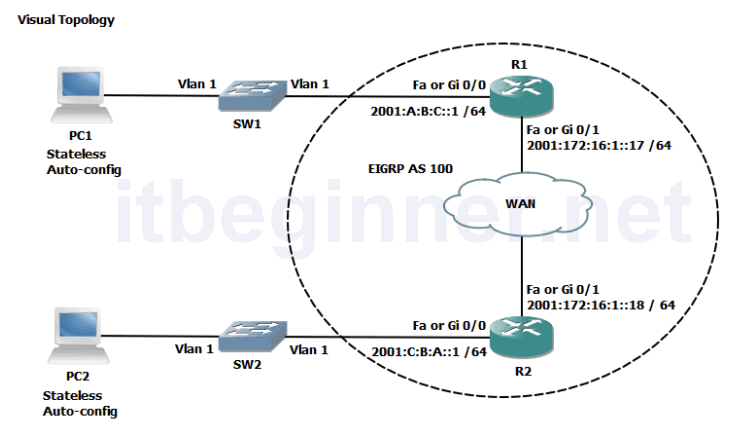
Command List
| Command | Description |
|---|---|
| ipv6 address address / mask | Applies an IPv6 address to an interface |
| ipv6 eigrp AS number | Configures EIGRP for IPv6 on an interface |
| ipv6 router eigrp AS number | Enters the IPv6 EIGRP configuration mode |
| ipv6 unicast-routing | Enables IPv6 unicast-routing between interfaces |
| show ipv6 eigrp interfaces | Displays IPv6 EIGRP interfaces statistics |
| show ipv6 eigrp neighbors | Displays contents of the IPv6 EIGRP neighbours table |
| show ipv6 eigrp topology | Displays contents of the IPv6 EIGRP topology table |
| show ipv6 interface | Displays IPv6 interface setup |
| show ipv6 route | Displays contents of the IPv6 routing table (best paths) |
Task 1: Setting up IPv6 on the Interface.
Step 1: Access the console port of the router.
Step 2: Assign the following IPv6 addresses.
| Router | Interface | IPv6 address and mask |
|---|---|---|
| R1 | fa0/0 or gi0/0 | 2001:A:B:C::1/64 |
| R1 | fa0/1 or gi0/1 | 2001:172:16:1::17/64 |
| R2 | fa0/0 or gi0/0 | 2001:C:B:A::1/64 |
| R2 | fa0/1 or gi0/1 | 2001:172:16:1::18/64 |
Step 3: Check the status of the interfaces and make sure they are up/up before continuing.
Step 4: Enter a command which enables routing between the interfaces.
Step 5: Examine the contents of the IPv6 routing table.

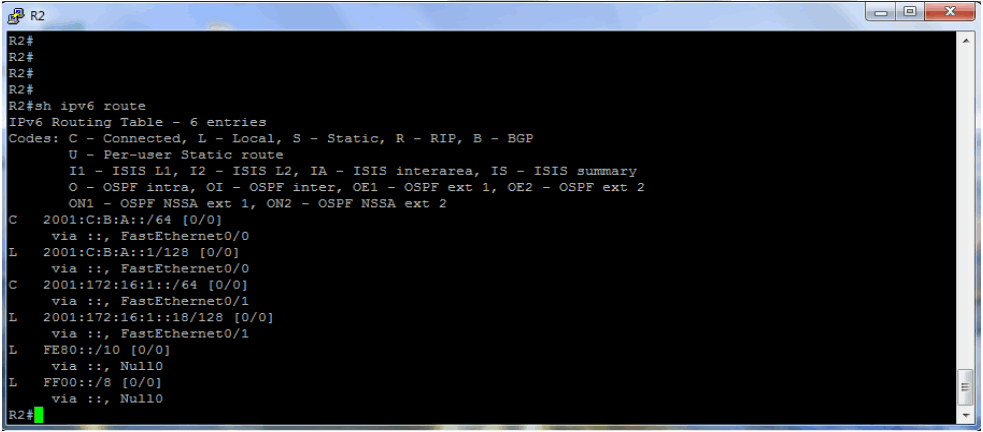
Step 6: Check whether or not your PC has automatically created a global IPv6 address.
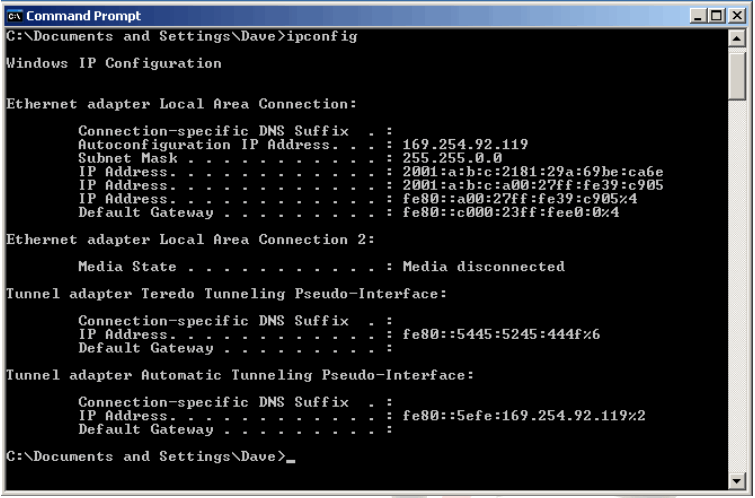
This is an example output on PC1 and please note the IPv6 addresses, both global and linklocal addresses are present in the displayed output.
Based on the above information, can you run IPv4 and IPv6 on the same interface? And If I run IPv4 and IPv6 on the same router do I have separate routing, topology and neighborship tables?
Task 2: Enabling EIGRP for IPv6.
Step 1: Enable EIGRP for IPv6 and set an autonomous number of 100.
NB: EIGRP can use a shutdown feature when you are in router configuration mode, execute the no shutdown just in case EIGRP isn’t enabled by default.
Step 2: Use the appropriate commands to associate both the ethernet interfaces with the routing process you have just enabled. Very important you shutdown the interfaces before you apply the command, remember to enable the interface once you have configured them.
Step 3: Navigate through some of the show commands and examine the output details.
You should see similar displays to the following.
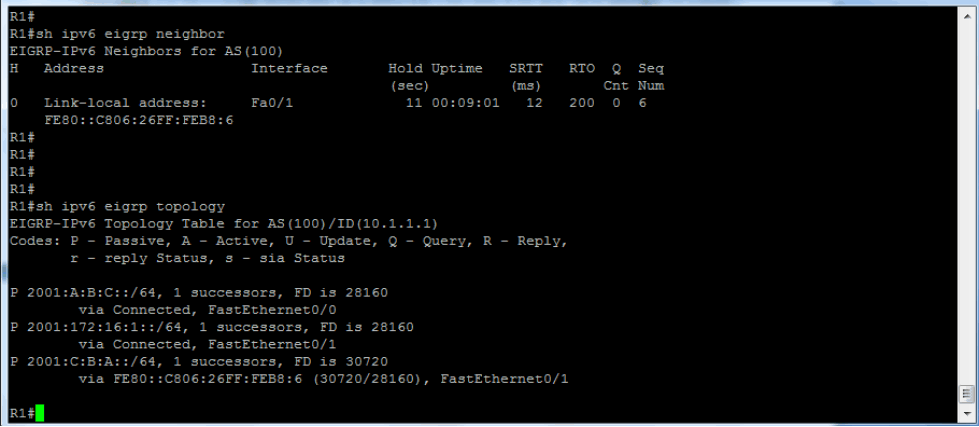
When using the sh ipv6 eigrp nei command please observe that the link-local address is shown instead of the global address.

The output of the sh ipv6 protocol command references a number of key values which were also present in EIGRP for IPv4. However there is no mention of auto-summarization!
Do any IPv6 routing protocols support auto-summarization at the classful boundary point and if not, why not?
Step 4: Disable EIGRP for IPv6
R(config)#no ipv6 router eigrp 100 R(config)#int range fa0/0 - 1 R(config-if-range)#shut R(config-if-range)#no ipv6 eigrp 100 R(config-if-range)#no shut
Step 5: Save your running-config
Lab Answer Keys:
[sociallocker id=”4139″]
Task 1: Setting up IPv6 on the Interface.
Step 2: Assign the following IPv6 addresses.
R1 only.... R1(config)#int fa0/0
or
R1(config)#int gi0/0 R1(config-if)#ipv6 address 2001:a:b:c::1/64 R1(config-if)#no shut R1(config-if)#int fa0/1
or
R1(config-if)#int gi0/1 R1(config-if)#ipv6 address 2001:172:16:1::17/64 R1(config-if)#no shut
R2 only.... R2(config)#int fa0/0
or
R2(config)#int gi0/0 R2(config-if)#ipv6 address 2001:c:b:a::1/64 R2(config-if)#no shut R2(config-if)#int fa0/1
or
R2(config-if)#int gi0/1 R2(config-if)#ipv6 address 2001:172:16:1::18/64 R1(config-if)#no shut
| Router | Interface | IPv6 address and mask |
|---|---|---|
| R1 | fa0/0 or gi0/0 | 2001:A:B:C::1/64 |
| R1 | fa0/1 or gi0/1 | 2001:172:16:1::17/64 |
| R2 | fa0/0 or gi0/0 | 2001:C:B:A::1/64 |
| R2 | fa0/1 or gi0/1 | 2001:172:16:1::18/64 |
Step 3: Check the status of the interfaces and make sure they are up/up before continuing.
R#sh ipv6 int brief
Step 4: Enter a command which enables routing between the interfaces.
R(config)#ipv6 unicast-routing
Step 5: Examine the contents of the IPv6 routing table.
R#sh ipv6 route
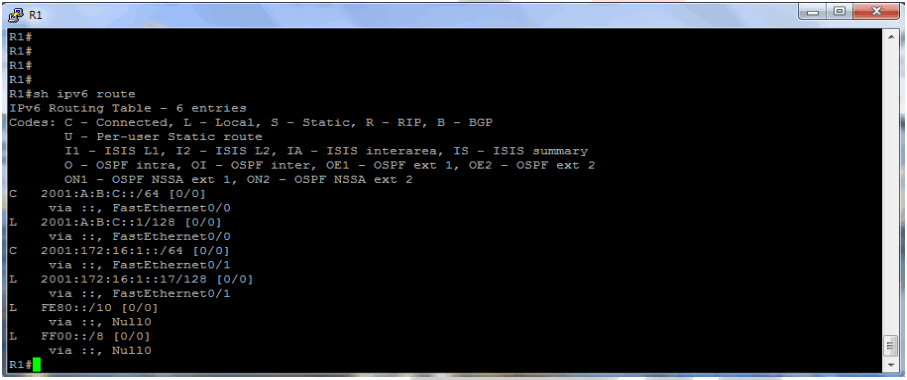
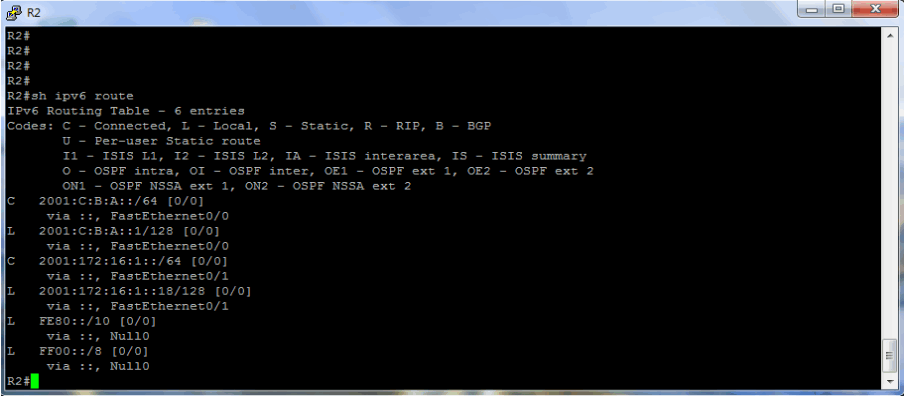
Step 6: Check whether or not your PC has automatically created a global IPv6 address.
C:\>ipconfig

This is an example output on PC1 and please note the IPv6 addresses, both global and linklocal addresses are present in the displayed output.
Based on the above information, can you run IPv4 and IPv6 on the same interface? And If I run IPv4 and IPv6 on the same router do I have separate routing, topology and neighbourship tables?
Yes, you can run both IPv4 and IPv6 on the same interface (dual stacking).
IPv4 and IPv6 protocols require separate processing tables, you can’t place an IPv4 route into an IPv6 table and vice versa.
Task 2: Enabling EIGRP for IPv6.
Step 1: Enable EIGRP for IPv6 and set an autonomous number of 100.
R(config)#ipv6 router eigrp 100 R(config-router)#no shutdown
NB: EIGRP can use a shutdown feature when you are in router configuration mode, execute the no shutdown just in case EIGRP isn’t enabled by default.
Step 2: Use the appropriate commands to associate both the ethernet interfaces with the routing process you have just enabled. Very important you shutdown the interfaces before you apply the command, remember to enable the interface once you have configured them.
R(config)#int range fa0/0 - 1
or
R(config)#int range gi0/0 - 1 R(config-if-range)#shut R(config-if-range)#ipv6 eigrp 100 R(config-if-range)#no shut
Step 3: Navigate through some of the show commands and examine the output details.
The output of the sh ipv6 protocol command references a number of key values which were also present in EIGRP for IPv4. However there is no mention of auto-summarization!
Do any IPv6 routing protocols support auto-summarization at the classful boundary point and if not, why not?
IPv6 is a classless routable protocol, there is no concept of classful boundaries so autosummarization doesn’t exist.
Step 4: Disable EIGRP for IPv6
R(config)#no ipv6 router eigrp 100 R(config)#int range fa0/0 - 1 R(config-if-range)#shut R(config-if-range)#no ipv6 eigrp 100 R(config-if-range)#no shut
Step 5: Save your running-config
R#copy run start
[/sociallocker]
